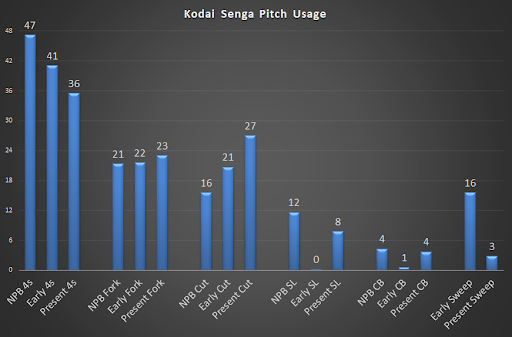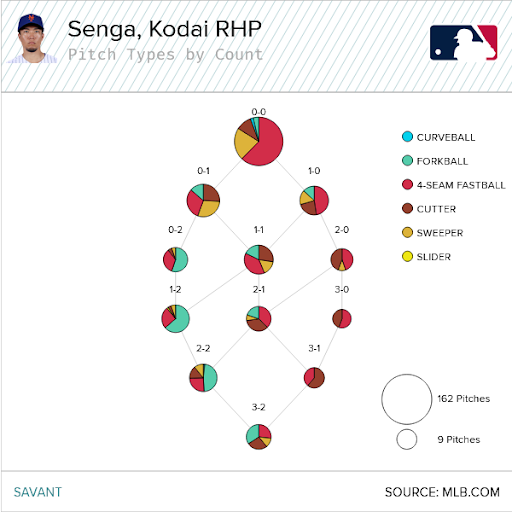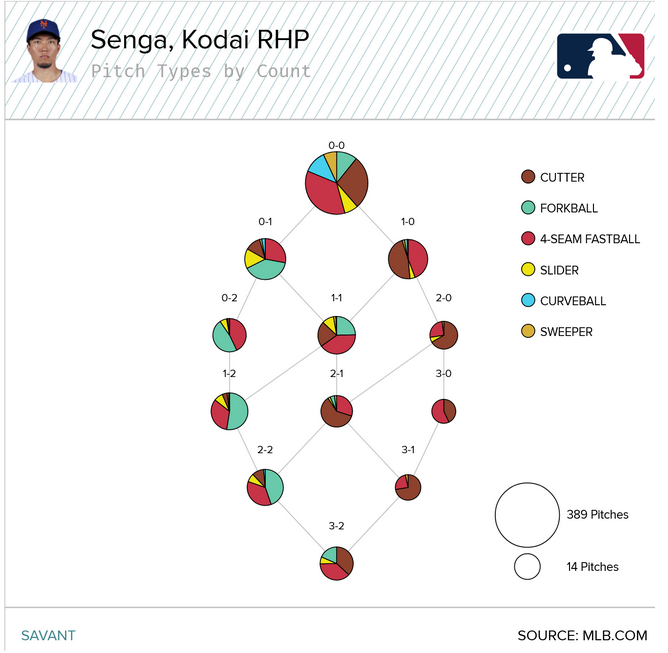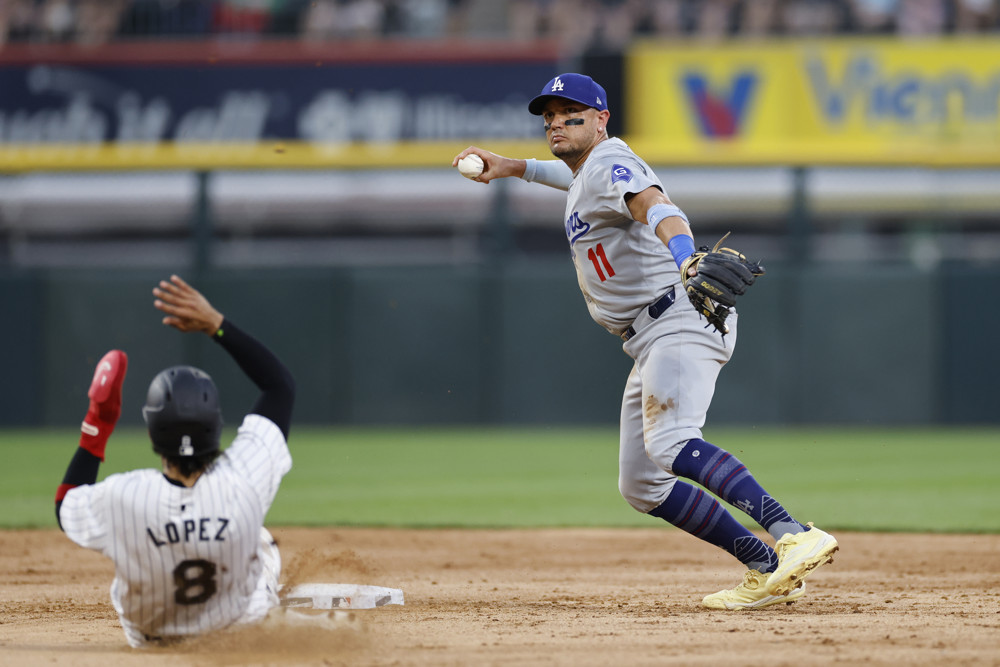Photo by Wilfred Perez/Icon Sportswire
Kodai Senga has come to Major League Baseball and immediately cemented himself as a top of the rotation pitcher. In his first season in MLB Senga has put up the 12th-lowest ERA among qualified pitchers with a 3.19. He’s also totaled the 9th highest K% (28%) and the 15th best swinging strike rate (12.5%).
It’s worth mentioning that Senga is doing this with a baseball completely different from what he was used to. MLB baseballs are slightly bigger and less tacky compared to NPB baseballs.
Senga had a 4.14 ERA in his first 7 starts. But in his 8th start, May 17 vs the Rays, it seems like things clicked for him. In that start Senga went 6 innings, struck out 12 and allowed only 1 earned run. There’s been notable differences in how Senga has used all of his pitches since that game. The results have been there. He’s dropped his season ERA by nearly a full point.
Brandon Tew and I wanted to see how much he’s changed from last season in Japan. Brandon will touch on how he worked in Japan in 2022 and I will dive into Senga this season. If you want a more in-depth look at Senga in NPB you can read it here.

4-seam fastball
NPB: Senga was reliant on early-count fastballs to get ahead of hitters early. This would bite him every now and then as he gave up 4 HRs off the fastball. The threat of getting beaten on a badly-located fastball was still minimal so it didn’t stop him from using it.
MLB: Senga’s 4-seam is still his most used pitch but the usage continues to decline. This is mostly because the shape of it isn’t great. It has just above-average ride so he struggles to get swings and misses (a 16.7% whiff rate).
Senga doesn’t even rank in the Top 200 in fastball induced vertical break (iVB) with an iVB of 16.4 inches, not far above the league average of 15.7. For reference, the best iVB is Felix Bautista with 20.5 inches. Basically, Senga’s fastball doesn’t have much deception compared to others.
Hitters aren’t necessarily crushing his fastball relative to other pitchers. they have a .267 avg, .424 slug with 6 home runs (MLB average fastball numbers are .270 and .448). The problem for Senga was the counts in which he has used the fastball. He was using the fastball in the “traditional” fastball counts, so hitters were ready for it.
Here’s a graphic from Baseball Savant showing Senga’s usage by count in his first 7 starts. He was using the 4-seamer earlier in counts, similar to when he used it in Japan. Now he’s started to use the cutter early in counts and save the fastball for late in the ABs. With 2 strikes the fastball usage has gone from 28% to 37%.

The splits this season for the fastball when the batter is ahead vs when the batter is behind show decisively different numbers, particularly with his whiff rate.
Batter ahead: .288 avg .441 slg 8% whiff
Batter behind: .234 avg .404 slg 24% whiff
Using the fastball late in counts is super effective because of the way it tunnels with his forkball. Because his forkball is so nasty, hitters have to be ready for it late in counts. Senga uses this to his advantage and surprises them with his fastball.
Cutter
NPB: Senga mainly attacked the best hitters in NPB with his cutter. He threw it mainly inside to LHBs but he would throw the pitch to different quadrants. Including down and away from RHBs or backdooring it to lefties.
MLB: Senga’s cutter has become not just his most important pitch, but one of the best pitches in all of baseball. The cutter has totaled a 17 Run Value, the highest for a cutter, and 10th-best for any pitch in baseball.
In 127 ABs ending with one, hitters have only a .205 avg and .268 slg. He generates a 51% ground ball rate against it. His ability to make it move late and get just under the barrel makes it difficult for hitters to square up.
Similar to when he was in NPB, he will throw it anywhere, but he can change the shape of it too. Sometimes it cuts, sometimes it goes straight down, and sometimes he can make it move arm side.
This usage by count breakdown shows his usages since the May 11 start. His cutter usage has seen a big increase in counts where the hitter has the advantage. In the first 7 starts, he used it 34% when he was behind in the count, it’s up to 51% since.

Forkball
NPB: The forkball was Senga’s best weapon. He threw it more than any other pitch in 2-strike counts and over half his strikeouts came with it. The pitch would consistently fool hitters because they had to gear up for his fastball.
MLB: Senga’s forkball is one of the nastiest pitches in all of baseball. For pitch types with at least 100 plate appearances here are some ranks for Senga’s forkball:
.128 avg (7th-lowest)
.152 slg (2nd-lowest)
58.6% whiff (1st)
55.9% K (2nd)
The tunnel effect he gets on the forkball and 4-seamer make it incredibly difficult for hitters to pick up on. Senga’s average vertical break on the forkball is 37.5 inches.
The key is that it stays on the same plane as the fastball for such a long time then drops off a cliff. Here’s an example in video form from Pitching Ninja.
Kodai Senga, 94mph Fastball and 82mph Ghost Fork, Individual Pitches + Overlay pic.twitter.com/459bgd4a5Y
— Rob Friedman (@PitchingNinja) July 28, 2023
Not only is Senga’s tunneling with his forkball and fastball elite but the velocity differential between the 2 pitches is one of the best in baseball (compared to other pitchers’ splitter/fastball differential). Senga gets a 12.4 mph difference between the 2 pitches, 2nd-best to only Fernando Cruz who gets 12.8 mph.
Curveball
NPB: Senga had two different curveballs, a 12-6 curve (mid 70s MPH) and one that was slurvy (low 80s mph). He had trouble keeping the shape consistent with both of them. He struggled to use the pitches effectively because of that but the change of speed helped keep hitters off balance.
MLB: Senga has separated his two curveballs since coming to MLB. His curveball this season is 12-6 with big drop and thrown super slow (73 MPH).
He uses it to surprise hitters and steal strikes a few times a game. He’s thrown 61 CBs, 49 of them have been first pitches of ABs.
Sweeper
MLB: We think the slurvy variation of Senga’s curveball in Japan is what is being classified as his sweeper.
His sweeper has a lot of drop and not much sweep. Compared to other sweepers thrown at similar velocity (81 MPH) and release height to Senga’s, he gets 4 inches more drop and 2.1 inches less sweep.
The sweeper has been his worst pitch. Hitters are 7 for 21 with a .952 slug, including 4 homeruns. The break of the sweeper is pretty lazy and thus easy for hitters to track.
Slider
NPB: Senga’s slider was always a work in progress. He spun it well but was never consistent. He only used it to give hitters a different look, it wasn’t a main part of his plan.
MLB: The slider he began throwing as an alternative to the sweeper has been effective. Hitters are only 5-for-25, with all the hits being singles. It’s a gyro slider with high spin and sharp break. He’s done a great job of picking certain hitters and spots to use it in.
Summation
These 12 strikeouts against the Diamondbacks on July 5 show how difficult Senga can be to face with his repertoire. Bad swings on forkballs, fastballs taken down the middle, plus some help from the pitch clock.
Kodai Senga matched a career high with 12 strikeouts tonight pic.twitter.com/nYrRl30OGh
— SNY (@SNYtv) July 6, 2023
Senga’s already put his name into the Rookie of the Year conversation. As he continues to evolve, he could become the favorite after a few more starts.


